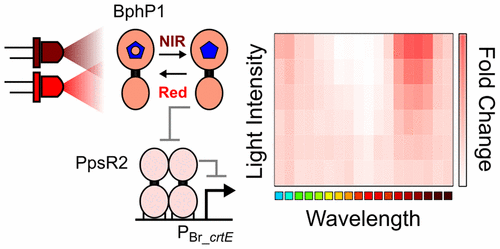当前位置:
X-MOL 学术
›
ACS Synth. Biol.
›
论文详情
Our official English website, www.x-mol.net, welcomes your
feedback! (Note: you will need to create a separate account there.)
Engineering an E. coli Near-Infrared Light Sensor
ACS Synthetic Biology ( IF 3.7 ) Pub Date : 2017-11-09 00:00:00 , DOI: 10.1021/acssynbio.7b00289 Nicholas T. Ong 1 , Evan J. Olson 1 , Jeffrey J. Tabor 1
ACS Synthetic Biology ( IF 3.7 ) Pub Date : 2017-11-09 00:00:00 , DOI: 10.1021/acssynbio.7b00289 Nicholas T. Ong 1 , Evan J. Olson 1 , Jeffrey J. Tabor 1
Affiliation

|
Optogenetics is a technology wherein researchers combine light and genetically engineered photoreceptors to control biological processes with unrivaled precision. Near-infrared (NIR) wavelengths (>700 nm) are desirable optogenetic inputs due to their low phototoxicity and spectral isolation from most photoproteins. The bacteriophytochrome photoreceptor 1 (BphP1), found in several purple photosynthetic bacteria, senses NIR light and activates transcription of photosystem promoters by binding to and inhibiting the transcriptional repressor PpsR2. Here, we examine the response of a library of output promoters to increasing levels of Rhodopseudomonas palustris PpsR2 expression, and we identify that of Bradyrhizobium sp. BTAi1 crtE as the most strongly repressed in Escherichia coli. Next, we optimize Rps. palustris bphP1 and ppsR2 expression in a strain engineered to produce the required chromophore biliverdin IXα in order to demonstrate NIR-activated transcription. Unlike a previously engineered bacterial NIR photoreceptor, our system does not require production of a second messenger, and it exhibits rapid response dynamics. It is also the most red-shifted bacterial optogenetic tool yet reported by approximately 50 nm. Accordingly, our BphP1–PpsR2 system has numerous applications in bacterial optogenetics.
中文翻译:

工程化大肠杆菌近红外光传感器
光遗传学是一项技术,研究人员可以将光和基因工程的感光体结合在一起,以无与伦比的精确度控制生物过程。近红外(NIR)波长(> 700 nm)是理想的光遗传学输入,因为它们的光毒性低,并且与大多数光蛋白的光谱分离。在几种紫色光合细菌中发现的细菌植物色素感光剂1(BphP1)通过结合并抑制转录抑制因子PpsR2来感知NIR光并激活光系统启动子的转录。在这里,我们检查了输出启动子文库对大红假单胞菌PpsR2表达水平升高的响应,并鉴定了缓生根瘤菌。BTAi1 crtE作为大肠杆菌中受抑制最强的。接下来,我们优化Rps。 为了证明NIR激活的转录,在经过工程改造以产生所需的发色团biliverdinIXα的菌株中表达palustris bphP1和ppsR2。与以前设计的细菌NIR感光器不同,我们的系统不需要生产第二个信使,并且显示出快速的响应动态。它也是迄今报道的最红移的细菌光遗传学工具,波长约为50 nm。因此,我们的BphP1-PpsR2系统在细菌光遗传学中有许多应用。
更新日期:2017-11-09
中文翻译:

工程化大肠杆菌近红外光传感器
光遗传学是一项技术,研究人员可以将光和基因工程的感光体结合在一起,以无与伦比的精确度控制生物过程。近红外(NIR)波长(> 700 nm)是理想的光遗传学输入,因为它们的光毒性低,并且与大多数光蛋白的光谱分离。在几种紫色光合细菌中发现的细菌植物色素感光剂1(BphP1)通过结合并抑制转录抑制因子PpsR2来感知NIR光并激活光系统启动子的转录。在这里,我们检查了输出启动子文库对大红假单胞菌PpsR2表达水平升高的响应,并鉴定了缓生根瘤菌。BTAi1 crtE作为大肠杆菌中受抑制最强的。接下来,我们优化Rps。 为了证明NIR激活的转录,在经过工程改造以产生所需的发色团biliverdinIXα的菌株中表达palustris bphP1和ppsR2。与以前设计的细菌NIR感光器不同,我们的系统不需要生产第二个信使,并且显示出快速的响应动态。它也是迄今报道的最红移的细菌光遗传学工具,波长约为50 nm。因此,我们的BphP1-PpsR2系统在细菌光遗传学中有许多应用。











































 京公网安备 11010802027423号
京公网安备 11010802027423号